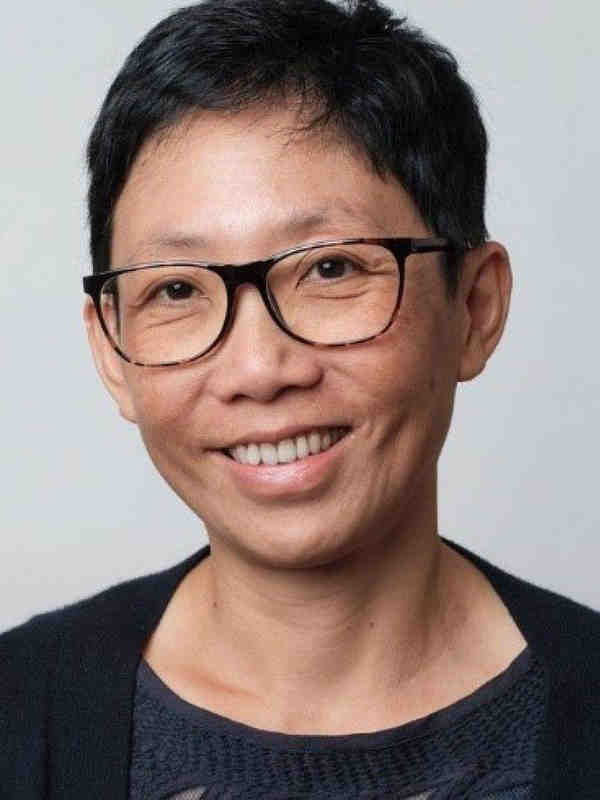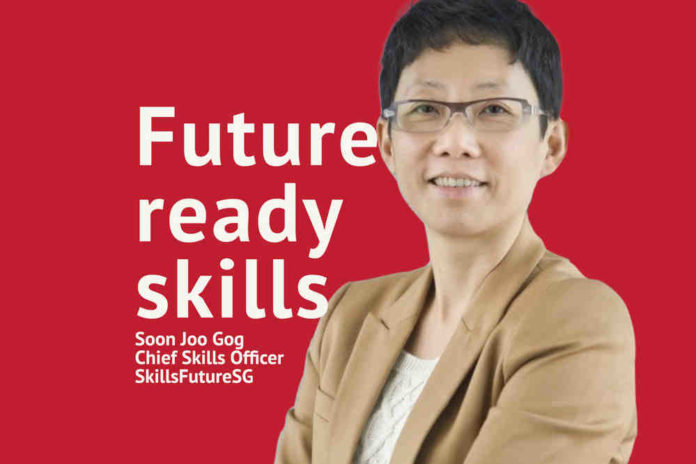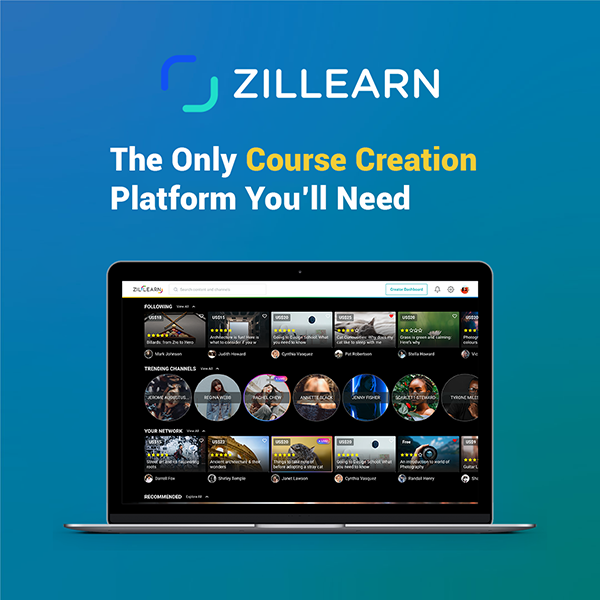The onset of the COVID-19 pandemic led to a re-imagining of the training, education, and workforce ecosystem. SkillsFuture Singapore, where Soon Joo Gog is Chief Futurist, Chief Skills Officer, and Chief Research Officer, has been a beacon of light during uncertain times.
SkillsFuture Singapore is a government agency under the Ministry of Education. It promotes a culture of lifelong learning, skills pursuit, and a quality ecosystem of adult education and training in Singapore.

The backdrop of record unemployment in Singapore sparked collaboration and innovation within the local EdTech space. Work continues on a project building an employability platform under the auspices of the city-state’s Emerging Stronger Taskforce.
SkillsFuture Singapore gives its citizens aged 25 and above a $500 SGD credit to offset the cost of coursework and training. The stipend aims to encourage individual ownership of skills development, fostering a growth mindset of learning for life.
This training allowance is just-in-time for upskilling and reskilling. The freshly retrenched are under economic strain, while those in jobs are concerned about their current skill set and wary of an increasingly automated future.
Through SkillsFuture Singapore, learners are being positioned to support a nascent ecosystem of skills and knowledge facilitators. Most critical is to encourage intentional learning in the global reskilling emergency.
Workers learn to remain relevant while identifying new roles and opportunities created by the fourth industrial revolution, and enterprises can support learning that yields performance outcomes.
Editor’s Note: Our interview with Soon Joo is the second in a series offering stakeholders of the EduTech Alliance an opportunity to share their thoughts on the future of learning and work.
Below is the full video interview with Soon Joo. You can jump to adapted highlights in the sections below:
What is SkillsFuture Singapore?
SkillsFuture Singapore is an agency. But it’s also a movement that was launched in 2015. At that point in time, Deputy Prime Minister Tharman Shanmugaratnam wanted to see how can we mobilize to build a society that values skills.
We embarked on lifelong learning. The intent is very simple. It’s about ensuring every Singaporean has the opportunity to realize their fullest potential through continuous lifelong learning.
How does SkillsFuture support job upskilling?
I lead a team of job skills analysts who look at global trends, regional trends, and local trends in terms of business model change, technology deployment and how it impacts job and skills.
They will disseminate these insights to individuals, enterprises, employers and also to education and training institutions so that we can make sure that the demand and supply of skills can try to close the skills gap.
I also work with a team of data scientists. They look at data from job postings, from CVs, to identify emerging skills. The two teams combined together will give us the kind of insights we need to identify, emerging, future, and in-demand skills for Singapore.
How’s the participation in workforce training?
Since 2015, the workforce training participation rate has scaled new heights year after year. As of 2019, we have managed to achieve 48% of individuals in the workforce having attended at least one structured training in the year before.
Compared to pre-SkilsFutureSG, it was around 32%. We think it’s a good jump, but this is not where we want to land. We want to land higher. At least 60-70% of the workforce should be able to participate at all times.
How has learning for career or workplace changed?
Today the ecosystem — in terms purposeful learning that will lead to an outcome for individual careers or businesses — is more complex than ever before.
It is no longer about having content, or having a course, and expecting your buyers — whether it’s corporate buyers or individual buyers — to come and buy the course and that’s it.
It is about what is the intent of the consumer when buying this course — be it individuals, be it enterprises. So when you look beyond and say that, “I am going to help my consumer or my clients to achieve either a career outcome, or a skills outcome, or a future outcome that they want.”
Similarly, for corporate clients — what exactly do they want? As an employer, they will send staff for training. It is always about business outcomes.
It is beyond content. Content is free. Content means you can Google, you can YouTube, you can do many things. You can get the most simple to more in depth content. So it’s not about it’s not about, I think today the most challenging part for the education and training industry is not content.
Firstly, be user-centric and say what exactly is the outcome you want to achieve, then design the kind of learning path for them to acquire the learning, experience of learning, and translate their learning into performance at workplaces.
How did the pandemic disrupt upskilling and reskilling?
COVID-19 was a major disruption to our work plan internally. Everybody is going to war. I used the analogy of going to war because suddenly there are a lot of lockdowns. We were anticipating training would be disrupted because of the “circuit breaker.”
You can’t be doing face to face. We had to decide very quickly how we were going to support online learning. That was one of the biggest changes for the education training industry.
We were very lucky. All this while we’ve been promoting — since 2015 onwards — learning innovations about going beyond just face to face learning. So all this time of online learning has come into fruition, and quite quickly we pivoted.
How does technology help learning?
Today there’s a lot of technology-enabled tools. It can be auto-curation of content using AI. You can also allow people to create content online to share with each other.
So this kind of authoring platform is very important because it means every expert, every practitioner can be a teacher and can be a facilitator. Community-based learning is important. Technology can enable the assessment of skills.
The corporations’ needs and individuals’ needs are quite different. So they may want to see the return on investment. What kind of skills dashboard can you display to your learners and corporate clients? So it requires a whole ecosystem to pull all this in together to make it user friendly.
So today, I would say that the learning management system of yesteryear is no longer adequate because the typical learning management system is designed for the administrator to administer resources, deploy content, monitor learner, deploy trainer, deploy a facilitator. I think that is definitely inadequate.
We need to bring together this learning technology alliance to help people navigate their career and their lifelong learning. A corporation may want to navigate their changing of skills and profile their staff because their operating model is changing, or navigating what kind of new skill sets they need because the whole company is going to a new line of business.
How can skills gaps be avoided?
My personal view is that we can never close skills gaps because we’re chasing after something that’s evolving all the time.
The market is changing rapidly. Industries are running fast ahead. With all their technology, you can see that they’re releasing new applications, new kinds of tools, new kinds of software all the time. So we’ll always be chasing.
Are we able to anticipate? So that’s where the deployment of data will help a country such as ourselves, which is what SkillsFutureSG is trying to do. We use big data to understand the coming trends.
For example, are we able to identify the kind of technology trends that are going to sweep industries globally? If we can do it in an anticipatory manner, it will close the skills gap faster.
I think that the issue is how fast we can be on the ground. To run as fast as they can to catch up with the skills that they need for their own jobs. Individual sensing is very important.
It’s not just about policymakers releasing news that you’ve got to train this, you’ve got to train that. Individuals’ antennas will be up to say, “Hey, I think my job is going to change. And how can I quickly reskill myself ahead of time?”
How must adult education institutions change?
The education and training industry — they are also moving and making a lot of changes. In Singapore, the biggest shift for our institutes of higher learning, universities, polytechnics, and ITEs is that they have repurposed or repositioned themselves as a lifelong learning institution.
So we will have a pool of trusted partners who will always be looking for new courses, new kinds of skills that they need to retrain. Some of them are setting up future foresight offices to see how they can also anticipate the new skills needed.
If they can translate R&D into the curriculum, then that’s where we should be able to close the skills gap faster.
Can upskilling and reskilling fix unemployment?
It is not the first time that we’re managing the unemployment rate. Pre-COVID, our unemployment rate is pretty low — about 2% — almost near full employment.
But we already have systems, processes, and schemes to help people who want to move into a new job, or if they were retrenched, to find suitable courses for a career path that they want to go into. We have a career conversion program. We have a work trial program.
We have a career center. During the COVID period, they actually scaled up, setting up satellite centers so individuals can go have a conversation with a career counselor.
We recently piloted a career learning GPS. It’s like a global positioning system, but it’s for yourself. What kind of options do I have? How much does it cost me? How much does it cost me in terms of time and resources? And what is the yield in return?
These kind of tools that we deploy, or an algorithm we design on the ground, will be very important to help people make decisions. So these are things where we are continuously trying to see how we can better identify high growth jobs, and help people identify how easy or how difficult it is to go into a new job.
At the end of the day, while all these programs are available, it really takes the individuals’ courage to say that “I want to step out of my comfort zone.”
The government has been doing it on the ground together with partners to make sure that Singaporeans have adequate insight and adequate information to make that choice.
On top that we have the funding scheme for Singaporeans. We have the Skillsfuture credits that will try to defray the out of pocket costs especially during this period of COVID, to have a training allowance to help them with reskilling.
Can you share a career change story?
There was a 60-year-old engineer who decided he didn’t want to retire. He spent two years retraining to be a clinical nurse. This is a fabulous story. It demystifies age and demystifies that an engineer can’t be doing a care job. It is not true. We can if we’re determined to do so. There are dozens and dozens of real Singaporeans successfully pivoting.
What is the future of Singapore’s workforce?
The pandemic proved that some of the jobs can actually do remote work. It doesn’t matter where you live. If you can deliver something through the Internet, across the border, through an email you actually can access that market.
The opportunities are there. How do we access and look out for it? Because luck is not accidental. You have to proactively pursue and create it for yourself.
You are seeing today that we have companies that we can no longer label as finance, or transport, or something else. The future will have to look at it with a different lens to see where the opportunity is.
I would say that the job content of the future is in every job role we will be required to work with machines. Machines means tools — equipment like a laptop, iPad or even how we’re gonna command equipment, command software to work. The content of us interacting with machines will be greater.
Let’s not forget that it’s not just about humans working with technology, but it’s also humans working with humans. And that part is what makes us all human.
Technology will bring us closer together and soft skills are important. How do we communicate with people? How do we influence others? How do we build inclusive work environments? How do we become trainers ourselves?
You all have the ability to develop others at the workplace.




